Over the last year, I was fortunate to help guide a study of the news consumption habits of college students, and coordinate Northeastern University Library’s services for the study, including great work by our data visualization specialist Steven Braun and necessary infrastructure from our digital team, including Sarah Sweeney and Hillary Corbett. “How Students Engage with News,” out today as both a long article and accompanying datasets and media, provides a full snapshot of how college students navigate our complex and high-velocity media environment.

This is a topic that should be of urgent interest to everyone since the themes of the report, although heightened due to the more active digital practices of young people, capture how we all find and digest news today, and also points to where such consumption is heading. On a personal level, I was thrilled to be a part of this study as a librarian who wants students to develop good habits of truth-seeking, and as an intellectual historian, who has studied changing approaches to truth-seeking over time.
You should first read the entire report, or at least the executive summary, now available on a special site at Project Information Literacy, with data hosted at Northeastern University Library’s Digital Repository System (where the study will also have its long-term, preserved form). It’s been great to work with, and think along with, the lead study members, including Alison Head, John Wihbey, Pakis Metaxas, and Margy MacMillan.
“How Students Engage with News” details how college students are overwhelmed by the flood of information they see every day on multiple websites and in numerous apps, an outcome of their extraordinarily frequent attention to smartphones and social media. Students are interested in news, and want to know what’s going on, but given the sheer scale and sources of news, they find themselves somewhat paralyzed. As humans naturally do in such situations, students often satisfice in terms of news sources—accepting “good enough,” proximate (from friends or media) descriptions rather than seeking out multiple perspectives or going to “canonical” sources of news, like newspapers. Furthermore, much of what they consume is visual rather than textual—internet genres like memes, gifs, and short videos play an outsized role in their digestion of the day’s events. (Side note: After recently seeing Yale Art Gallery’s show “Seriously Funny: Caricature Through the Centuries,” I think there’s a good article to be written about the historical parallels between today’s visual memes and political cartoons from the past.) Of course, the entire population faces the same issues around our media ecology, but students are an extreme case.
And perhaps also a cautionary tale. I think this study’s analysis and large survey size (nearly 6,000 students from a wide variety of institutions) should be a wake-up call for those of us who care about the future of the news and the truth. What will happen to the careful ways we pursue an accurate understanding of what is happening in the world by weighing information sources and developing methods for verifying what one hears, sees, and reads? Librarians, for instance, used to be much more of a go-to source for students to find reliable sources of the truth, but the study shows that only 7% of students today have consulted their friendly local librarian.
It is incumbent upon us to change this. A purely technological approach—for instance, “improving” social media feeds through “better” algorithms—will not truly solve the major issues identified in the news consumption study, since students will still be overwhelmed by the volume, context, and heterogeneity of news sources. A more active stance by librarians, journalists, educators, and others who convey truth-seeking habits is essential. Along these lines, for example, we’ve greatly increased the number of workshops on digital research, information literacy, and related topics at Northeastern University Library, and students are eager attendees at these workshops. We will continue to find other ways to get out from behind our desks and connect more with students where they are.
Finally, I have used the word “habit” very consciously throughout this post, since inculcating and developing more healthy habits around news consumption will also be critical. Alan Jacobs’ notion of cultivating “temporal bandwidth” is similar to what I imagine will have to happen in this generation—habits and social norms that push against the constant now of social media, and stretch and temper our understanding of events beyond our unhealthily caffeinated present.
